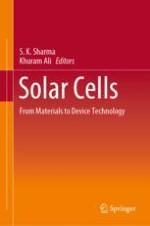2020 | OriginalPaper | Buchkapitel
Recent Advances in Solar Cells
verfasst von : Marcio A. P. Almeida
Erschienen in: Solar Cells
Aktivieren Sie unsere intelligente Suche, um passende Fachinhalte oder Patente zu finden.
Wählen Sie Textabschnitte aus um mit Künstlicher Intelligenz passenden Patente zu finden. powered by
Markieren Sie Textabschnitte, um KI-gestützt weitere passende Inhalte zu finden. powered by
